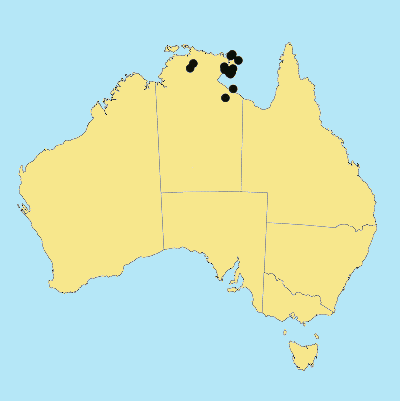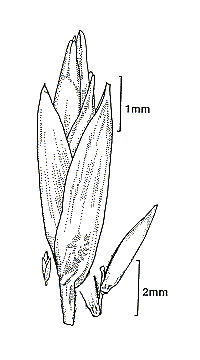Triodia procera R. Br. Prodr.
182 (1810).
Classification. (GPWG 2001) : Subfamily Chloridoideae. Triodeae.
Type of Basionym or
Protologue Information: LT: R. Brown [6256], Northern Territory:
Darwin and Gulf District; Gulf of Carpentaria, North Coast (BM, E?; ILT: BRI,
MEL). LT designated by Lazarides, Aust. Syst. Bot. 10(3): 462 (1997).
Key references
(books and floras): [1810]. R.Brown, Prodromus (182), [1878]
G.Bentham, Flora Australiensis 7 (607), [1952] C.A.Gardner, Flora of
Western Australia 1 Gramineae (67), [2002] D.Sharp & B.K.Simon, AusGrass,
Grasses of Australia.
Illustrations:
[1952] C.A.Gardner, Flora of Western Australia 1 Gramineae (72,
Pl. 22), [2005] K.Mallet (ed.), Flora of Australia 44B: Poaceae 3
(Fig. 35D-F).
Habit.
Perennial. Stolons present. Culms 150–200 cm tall. Leaf-sheaths glabrous on
surface. Leaf-sheath auricles absent. Ligule a fringe of hairs. Leaf-blades
ascending, linear, flat or conduplicate or involute, 35–100 cm long, 4–7 mm
wide.
Inflorescence.
Inflorescence compound, a panicle of racemes. Panicle 40–100 cm long, 5–9 cm
wide, contracted about primary branches.
Spikelets.
Spikelets pedicelled. Fertile spikelets many flowered, with at least 2 fertile
florets (3–4), comprising 3–4 fertile floret(s), with diminished florets at the
apex, oblong, laterally compressed, 4–9 mm long.
Glumes.
Glumes similar, thinner than fertile lemma. Lower glume oblong, scarious or
cartilaginous, without keels, 3 -nerved. Lower glume surface glabrous. Lower
glume apex muticous. Upper glume oblong, 3–4 mm long, scarious or
cartilaginous, without keels, 1 -nerved. Upper glume surface glabrous. Upper
glume apex entire, muticous.
Florets.
Fertile lemma 2.8–4.5 mm long, without keel, 3 -nerved. Lemma surface
indumented. Lemma apex dentate or lobed, muticous. Anthers 3.
Continental
Distribution: Australasia.
Australian
Distribution: Northern Territory.
Northern Territory:
Darwin & Gulf, Victoria River.
Notes.
Distinguished by its robust habit; bitextured lemma and palea; minutely lobed,
mostly glabrous lemma; truncate, glabrous, thickened callus.
Close to T. microstachya, but differs
in its usually larger spikelets, blunt (not acuminate) glumes, and indurated,
bitextured lemma and palea.
Monsoonal
regions of N.T., W.A. and Qld (including mainland and coastal islands). Deep,
often white, sandy and sandy loam soils; banks of seasonal and permanent
watercourses and billabongs; coastal dunes and vine thickets; rocky pavements,
slopes and crests of sandstone plateaux, escarpments, hills, outcrops and in
gorges; rocky river beds; dry rocky conglomerate ridges; coastal lateritic
headlands and foreshores; flowers Nov.-Mar. and July-Aug.



